Extreme Precipitation and Low-Lying Urban Flooding in Bahía Blanca, Argentina
Abstract
1. Introduction
2. Materials and Methods
2.1. Study Area
2.2. Flooding Detection

2.3. Meteorological Data
3. Results and Discussion
3.1. Flooding Characterisation
3.2. Meteorological Conditions
3.2.1. Weather Measurements at the Surface
3.2.2. Atmospheric Circulation and Instability
3.2.3. Mesoscale Environment
4. Concluding Remarks
- Bahía Blanca district presented flooded areas of approximately 33 km2 on 10 March (1.4% of the total area), most of them concentrated in the non-urbanized zones. A total of 18 km2 (0.8% of the total area) was still identified on 11 March, with a greater impact on the low-lying urban areas of the Bahía Blanca, General Daniel Cerri, and Ingeniero White towns. The study includes an interactive Earth Engine visualization tool for examining flood impacts through temporal urban condition comparisons [Supplementary Material: https://ee-revollonatalia.projects.earthengine.app/view/floodapp] (accessed on 21 April 2025).
- The low-lying urban flooding was produced by an exceptional precipitation of at least 290 mm in Bahía Blanca, with a total amount of 210 mm between 0600 UTC and 1200 UTC and 80 mm in the following 6 h period.
- The likelihood of severe weather conditions was confirmed from instability indices (e.g., Lifted Index, Showalter, Totals Totals, SWEAT, and K).
- The existence of a low-level convergence line, also characterized by warm air advection and very high atmospheric moisture content. In parallel, the upper-level divergence contributed to the development and maintenance of deep convective clouds that affected Bahía Blanca for at least 6 h.
- Satellite imagery indicated an agglomerate of convective clouds with brightness temperatures of around −70 °C most of the time, as well as overshooting tops at several moments.
Supplementary Materials
Author Contributions
Funding
Institutional Review Board Statement
Informed Consent Statement
Data Availability Statement
Acknowledgments
Conflicts of Interest
References
- Couto, F.T.; Kartsios, S.; Lacroix, M.; Andrade, H.N. A Quick Look at the Atmospheric Circulation Leading to Extreme Weather Phenomena on a Continental Scale. Atmosphere 2024, 15, 1205. [Google Scholar] [CrossRef]
- FinalReport. 2024. Available online: https://www.unocha.org/attachments/8dce9c2a-5774-42c3-84d1-f3300c9db7cf/Libya_Flash_Appeal_Final_Report_17%20November%202024.pdf (accessed on 16 March 2025).
- Normand, J.C.L.; Heggy, E. Assessing flash flood erosion following storm Daniel in Libya. Nat. Commun. 2024, 15, 6493. [Google Scholar] [CrossRef] [PubMed]
- Couto, F.T.; Salgado, R.; Costa, M.J. Analysis of intense rainfall events on Madeira Island during the 2009/2010 winter. Nat. Hazards Earth Syst. Sci. 2012, 12, 2225–2240. [Google Scholar] [CrossRef]
- Couto, F.T.; Ducrocq, V.; Salgado, R.; Costa, M.J. Numerical simulations of significant orographic precipitation in Madeira island. Atmos. Res. 2016, 169, 102–112. [Google Scholar] [CrossRef]
- Couto, F.T.; Ducrocq, V.; Salgado, R.; Costa, M.J. Understanding significant precipitation in Madeira island using high-resolution numerical simulations of real cases. Q. J. R. Meteorol. Soc. 2017, 143, 251–264. [Google Scholar] [CrossRef]
- Report. Available online: https://timorleste.un.org/en/129347-joint-appeal-flood-response-plan-timor-leste (accessed on 22 March 2025).
- Faria, M.; Ximenes, M.; de Jesus, O. Assessing Future Flooding Risk in a Coastal Lagoon Using Hydrogeological Approaches and Analysis of the 2021 Flood Event: A Case Study of Tasi-Tolu Lagoon, Dili, Timor-Leste. J. Water Resour. Prot. 2023, 15, 276–298. [Google Scholar] [CrossRef]
- Tam, H.C.; He, Y.-H.; Chan, P.W.; Yu, S.; Mo, H.; Su, H.; Hsiao, L.-F.; Gong, Y. Historical rainstorm in Hong Kong on 7–8 September 2023: Diagnosis, forecasting and nowcasting. Atmos. Sci. Lett. 2025, 26, e1284. [Google Scholar] [CrossRef]
- Matos-Pupo, F.; Peros, M.C.; González-De Zayas, R.; Valero-Jorge, A.; Pérez-López, O.E.; Álvarez-Taboada, F.; Sorí, R. Coastal Flooding Associated with Hurricane Irma in Central Cuba (Ciego de Ávila Province). Atmosphere 2023, 14, 1445. [Google Scholar] [CrossRef]
- Rasmussen, K.L.; Zuluaga, M.D.; Houze, R.A., Jr. Severe convection and lightning in subtropical South America. Geophys. Res. Lett. 2014, 41, 7359–7366. [Google Scholar] [CrossRef]
- Zipser, E.J.; Cecil, D.J.; Liu, C.; Nesbitt, S.W.; Yorty, D.P. Where are the most intense thunderstorms on earth? Bull. Am. Meteorol. Soc. 2006, 87, 1057–1072. [Google Scholar] [CrossRef]
- DiGangi, E.; Lapierre, J.; Stock, M.; Hoekzema, M.; Cunha, B. Analyzing Lightning Characteristics in Central and Southern South America. Electr. Power Syst. Res. 2022, 213, 108704. [Google Scholar] [CrossRef]
- Veloso-Aguila, D.; Rasmussen, K.L.; Maloney, E.D. Tornadoes in Southeast South America: Mesoscale to Planetary-Scale Environments. Mon. Weather Rev. 2024, 152, 295–318. [Google Scholar] [CrossRef]
- Cecil, D.J.; Blankenship, C.B. Toward a Global Climatology of Severe Hailstorms as Estimated by Satellite Passive Microwave Imagers. J. Clim. 2012, 25, 687–703. [Google Scholar] [CrossRef]
- Elkins, C.M.; Hence, D.A. Radar Survey of Hail-Producing Storms and Environments during the 2018–19 Severe-Weather Season in the Córdoba Region of Argentina. J. Appl. Meteor. Climatol. 2024, 63, 575–593. [Google Scholar] [CrossRef]
- Beal, A.; Hallak, R.; Martins, L.D.; Martins, J.A.; Biz, G.; Rudke, A.P.; Tarley, C.R. Climatology of hail in the triple border Paraná, Santa Catarina (Brazil) and Argentina. Atmos. Res. 2020, 234, 104747. [Google Scholar] [CrossRef]
- Salio, P.; Nicolini, M.; Zipser, E.J. Mesoscale Convective Systems over Southeastern South America and Their Relationship with the South American Low-Level Jet. Mon. Weather Rev. 2007, 135, 1290–1309. [Google Scholar] [CrossRef]
- Yabra, M.S.; Nicolini, M.; Borque, P.; Skabar, Y.G.; Salio, P. Observational study of the South American low-level jet during the SALLJEX. Int. J. Climatol. 2022, 42, 9676–9696. [Google Scholar] [CrossRef]
- Jones, C.; Mu, Y.; Carvalho, L.M.V.; Ding, Q. The South America Low-Level Jet: Form, variability and large-scale forcings. npj Clim. Atmos. Sci. 2023, 6, 175. [Google Scholar] [CrossRef]
- Sasaki, C.R.S.; Rowe, A.K.; McMurdie, L.A.; Varble, A.C.; Zhang, Z. Influences of the South American Low-Level Jet on the Convective Environment in Central Argentina Using a Convection-Permitting Simulation. Mon. Weather Rev. 2024, 152, 629–648. [Google Scholar] [CrossRef]
- Rehbein, A.; Prein, A.F.; Ambrizzi, T.; Ikeda, K.; Liu, C.; Rasmussen, R.M. 20 Years of MCSs simulations over South America using a convection-permitting model. Clim. Dyn. 2025, 63, 38. [Google Scholar] [CrossRef]
- Escobar, G.C.J.; Rosa, M.B. Synoptic patterns associated with heavy rainfall events in the metropolitan region of Porto Alegre, Brazil. Meteorol. Atmos. Phys. 2024, 136, 40. [Google Scholar] [CrossRef]
- Reboita, M.S.; Mattos, E.V.; Capucin, B.C.; Souza, D.O.D.; Ferreira, G.W.d.S. A Multi-Scale Analysis of the Extreme Precipitation in Southern Brazil in April/May 2024. Atmosphere 2024, 15, 1123. [Google Scholar] [CrossRef]
- NASA. Earth Observatory. Available online: https://earthobservatory.nasa.gov/images/152795/floods-engulf-porto-alegre (accessed on 18 March 2025).
- OCHA. United Nations. 2024. Available online: https://www.unocha.org/attachments/1a29a4e4-116d-4b66-b3e4-bb7399dd52f2/20240708%20BRAZIL%20Flooding%20Emergency%20-%20Snapshot.pdf (accessed on 16 March 2025).
- Lommen, D.; Wang, J.; Su, H.; Zhi, X.; Wang, X.; Park, E.; Zhang, H.; Lee, J.; Wong, M.C. Burst flooding in Singapore: An emerging urban flooding type revealed by high-temporal-resolution observations. Environ. Res. Lett. 2025, 20, 014012. [Google Scholar] [CrossRef]
- Shen, Y.; Zhang, B.; Chue, C.Y.; Wang, S. Improving Risk Projection and Mapping of Coastal Flood Hazards Caused by Typhoon-Induced Storm Surges and Extreme Sea Levels. Atmosphere 2023, 14, 52. [Google Scholar] [CrossRef]
- Farooq, U.; Taha Bakheit Taha, A.; Tian, F.; Yuan, X.; Ajmal, M.; Ullah, I.; Ahmad, M. Flood Modelling and Risk Analysis of Cinan Feizuo Flood Protection Area, Huaihe River Basin. Atmosphere 2023, 14, 678. [Google Scholar] [CrossRef]
- Basu, T.; Mondal, B.K.; Abdelrahman, K.; Fnais, M.S.; Praharaj, S. Assessing Urban Flood Hazard Vulnerability Using Multi-Criteria Decision Making and Geospatial Techniques in Nabadwip Municipality, West Bengal in India. Atmosphere 2023, 14, 669. [Google Scholar] [CrossRef]
- Louis, R.; Zech, Y.; Joseph, A.; Gonomy, N.; Soares-Frazao, S. Flood Modeling of the June 2023 Flooding of Léogâne City by the Overflow of the Rouyonne River in Haiti. Water 2024, 16, 2594. [Google Scholar] [CrossRef]
- Kang, S.; Lim, C. Detecting Inaccessible Flood Damage in North Korea Using Sentinel-1 Synthetic Aperture Radar Imagery: A Case of Flooding at 2023 Summer. Korean J. Remote Sens. 2025, 41, 173–184. [Google Scholar] [CrossRef]
- López, N.; Casado, A.; Revollo, N.V.; Gil, V. Potencial de escorrentía en función del número de curva en una cuenca serrana, Napostá Grande (Argentina): Runoff potential in function of the curve number in a mountain watershed, Napostá Grande (Argentina). Geosciences=Geociências 2023, 42, 402–418. [Google Scholar] [CrossRef]
- Galvanin, E.A.; Revollo, N.V.; de la Puente, F.J.B.; Gil, V.; da Silva Neves, S.M.A.; Zapperi, P. Monitoring and Mapping of the Brazilian Pantanal Wetland. In Vegetation Index and Dynamics-Methodologies for Teaching Plant Diversity and Conservation Status; IntechOpen: London, UK, 2023. [Google Scholar] [CrossRef]
- Rey, A.; Revollo, N.V.; Frery, A.C.; Delrieux, C. Automatic Delineation of Water Bodies in SAR Images with a Novel Stochastic Distance Approach. Remote Sens. 2022, 14, 5716. [Google Scholar] [CrossRef]
- Sarmiento, G.N.R.; Revollo, N.V.; Delrieux, C.A.; Perillo, G.M. Morphological characterization of ponds and tidal courses in coastal wetlands using Google Earth imagery. Estuar. Coast. Shelf Sci. 2020, 246, 107041. [Google Scholar] [CrossRef]
- Revollo, N.V.; Sarmiento, G.N.R.; Cisneros, M.A.H.; Delrieux, C.A.; Piccolo, M.C. Assessing the evolution in remotely sensed vegetation index using image processing techniques. Anuário Inst. Geociências–UFRJ 2019, 42, 27–41. [Google Scholar] [CrossRef]
- Cisneros, M.A.H.; Sarmiento, N.V.R.; Delrieux, C.A.; Piccolo, M.C.; Perillo, G.M. Beach carrying capacity assessment through image processing tools for coastal management. Ocean Coast. Manag. 2016, 130, 138–147. [Google Scholar] [CrossRef]
- Lambrecht, Y.; Picone, N.; Zapperi, P.; Gil, V. Evento de bow-echo y sus efectos sobre la ciudad de Bahía Blanca. Rev. FACENA 2024, 34, 138–157. [Google Scholar] [CrossRef]
- Bahía Blanca Large Hail in February 2025. Available online: https://tn.com.ar/sociedad/2025/02/02/una-fuerte-tormenta-de-granizo-y-viento-provoco-danos-calles-inundadas-y-cortes-de-luz-en-bahia-blanca/ (accessed on 21 March 2025).
- Sentinel-2, European Space Agency. Sentinel-2 Image, Bahía Blanca, Buenos Aires, Argentina. Copernicus Open Access Hub. 2025. Available online: https://browser.dataspace.copernicus.eu/ (accessed on 20 March 2025).
- McFeeters, S.K. The use of the Normalized Difference Water Index (NDWI) in the delineation of open water features. Int. J. Remote Sens. 1996, 17, 1425–1432. [Google Scholar] [CrossRef]
- Eidenshink, J.C. The 1990 conterminous U. S. AVHRR data set. Photogramm. Eng. Remote Sens. 1992, 58, 809–881. [Google Scholar]
- Marsh, S.E.; Walsh, J.L.; Lee, C.T.; Beck, L.; Hutchinson, C.F. Comparison of multi temporal NOAA-AVHRR and SPOT-XS data for mapping land cover dynamics in the West African Sahel. Int. J. Remote Sens. 1992, 13, 2997–3016. [Google Scholar] [CrossRef]
- Lyon, J.G.; Yuan, D.; Lunetta, R.; Elvidge, C. A change detection experiment using vegetation indices. (R825152). Photogramm. Eng. Remote Sens. 1998, 64, 143–150. [Google Scholar]
- OGIMET. Available online: www.ogimet.com (accessed on 18 March 2025).
- Centro de Hidrografia da Marinha (CHM). Available online: https://www.marinha.mil.br/chm/dados-do-smm-cartas-sinoticas/cartas-sinoticas (accessed on 18 March 2025).
- University of Wyoming. Upper-Air Data. Available online: https://weather.uwyo.edu/upperair/sounding.html (accessed on 18 March 2025).
- University of Wyoming. Instability Indices. Available online: https://weather.uwyo.edu/upperair/indices.html (accessed on 18 March 2025).
- Schmit, T.J.; Griffith, P.; Gunshor, M.M.; Daniels, J.M.; Goodman, S.J.; Lebair, W.J. A Closer Look at the ABI on the GOES-R Series. Bull. Am. Meteor. Soc. 2017, 98, 681–698. [Google Scholar] [CrossRef]
- INPE. Available online: https://www.cptec.inpe.br/dsat/ (accessed on 15 March 2025).
- Uba, D.M.; Machado, L.A.T.; de Paula Pereira, S.; de Souza, D.R.M.; Negri, R.G.; da Silva Batista, R. DSAT—Aplicação para visualização interativa dos dados recebidos pela estação GOES-R do INPE. In Proceedings of the Anais do XX Simpósio Brasileiro de Sensoriamento Remoto, Florianópolis, Brazil, 2–5 April 2023; Anais eletrônicos. INPE: São José dos Campos, Brazil, 2023. Available online: http://marte2.sid.inpe.br/col/sid.inpe.br/marte2/2023/05.02.23.47/doc/155358.pdf (accessed on 21 April 2025).
- ECMWF—MARS User Documentation. Available online: https://confluence.ecmwf.int/display/UDOC/MARS+user+documentation (accessed on 15 March 2025).
- ECMWF. Variable Description. Available online: https://codes.ecmwf.int/grib/param-db/ (accessed on 15 March 2025).
- Website. Available online: https://aguantebahia.com/ (accessed on 28 March 2025).
- Digital Elevation/Terrain Model (DEM). Available online: https://www.earthdata.nasa.gov/topics/land-surface/digital-elevation-terrain-model-dem (accessed on 20 March 2025).
- Servicio Meteorológico Nacional. Informe Sobre las Lluvias e Inundaciones en Bahía Blanca y Alrededores (4–8 de Marzo de 2025). 2025. Available online: https://www.smn.gob.ar/sites/default/files/Informe_Bahia%20Blanca_SMN_marzo_2025.pdf (accessed on 21 April 2025).
- Instability Indices. Available online: https://www.weather.gov/lmk/indices (accessed on 20 March 2025).
- Infobae. Available online: https://www.infobae.com/sociedad/2025/03/10/temporal-en-bahia-blanca-en-vivo-tras-las-consecuencias-de-la-inundacion-como-estara-el-clima-en-la-ciudad-este-lunes/ (accessed on 18 April 2025).
- Infobae. Available online: https://www.infobae.com/sociedad/2025/03/08/tragico-temporal-en-bahia-blanca-10-muertos-mas-de-mil-evacuados-y-perdidas-incalculables/ (accessed on 18 April 2025).
- Photo. Available online: https://www.mdzol.com/sociedad/2025/3/11/bahia-blanca-que-cubren-los-seguros-de-autos-frente-las-inundaciones-1193921.html (accessed on 30 March 2025).
- Shi, X.; Zhang, Y.; Liu, S.; Yang, L.; Yu, L.; Zhang, Y.; Jia, N.; Tian, Z. Mapping Storm Surge Risk at County Level in Coastal Areas of China. J. Mar. Sci. Eng. 2025, 13, 427. [Google Scholar] [CrossRef]
- Zapperi, P. Hidrografía Urbana de Bahía Blanca. Ph.D. Thesis, Universidad Nacional del Sur, Bahía Blanca, Argentina, 2012. Repositorio Institucional Digital de la Biblioteca Central “Profesor Nicolás Matijevic” de la Universidad Nacional del Sur. Available online: http://repositoriodigital.uns.edu.ar/handle/123456789/485 (accessed on 21 April 2025).
- Lambrecht, Y.; Zapperi, P. Impactos Directos de Eventos Pluviométricos en Áreas Urbanas. El Caso de la Ciudad Intermedia de Bahía Blanca (Provincia de Buenos Aires, República Argentina). Párrafos Geográficos. 2024. Available online: https://www.revistas.unp.edu.ar/index.php/parrafosgeograficos/article/view/1084 (accessed on 29 March 2025).
- Mastrandrea, A.; Perez, M.I. Representaciones sociales del riesgo hídrico: Análisis Crítico del Discurso periodístico en la cuenca del arroyo Napostá Grande (Bahía Blanca, Argentina). Rev. Univ. Geogr. 2022, 31, 19–22. [Google Scholar] [CrossRef]
- Vera, C.; Baez, J.; Douglas, M.; Emmanuel, C.B.; Marengo, J.; Meitin, J.; Nicolini, M.; Nogues-Paegle, J.; Paegle, J.; Penalba, O. The South American Low-Level Jet Experiment. Bull. Amer. Meteor. Soc. 2006, 87, 63–78. [Google Scholar] [CrossRef]
- Santiago, M.M.; Nunes, A.B.; Couto, F.T.; Almeida Bressiani, D.D.; Freitas, R.A.P.D.; Cardoso, I.P. Relationship Between the Water Vapor Transport from the Amazon Basin and the Rainfall Regime over a Watershed on Brazil’s Southern Border. Earth 2025, 6, 13. [Google Scholar] [CrossRef]
- Polomčić, D.; Bajić, D.; Ratković, J. Assessment of Historical Flood Risk to the Groundwater Regime: Case Study of the Kolubara Coal Basin, Serbia. Water 2018, 10, 588. [Google Scholar] [CrossRef]
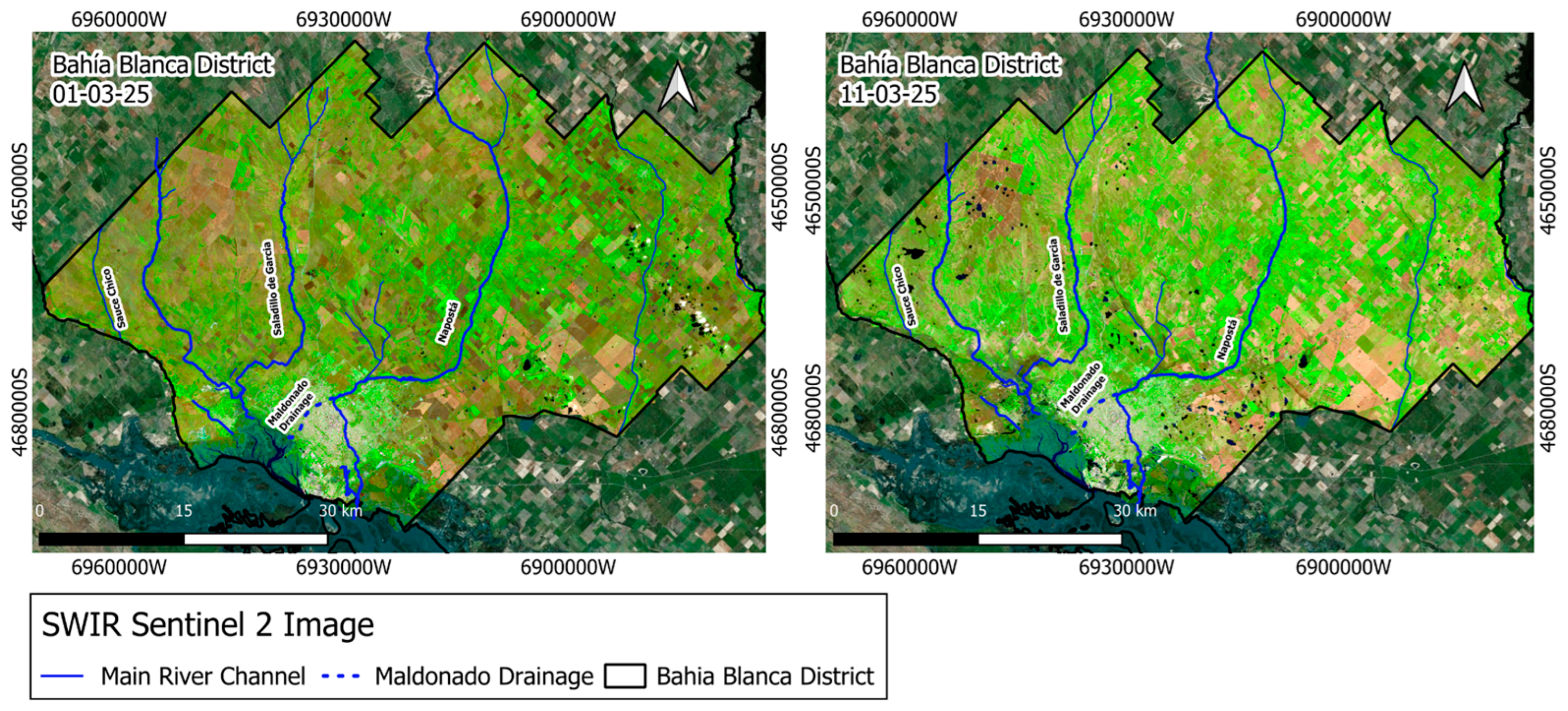

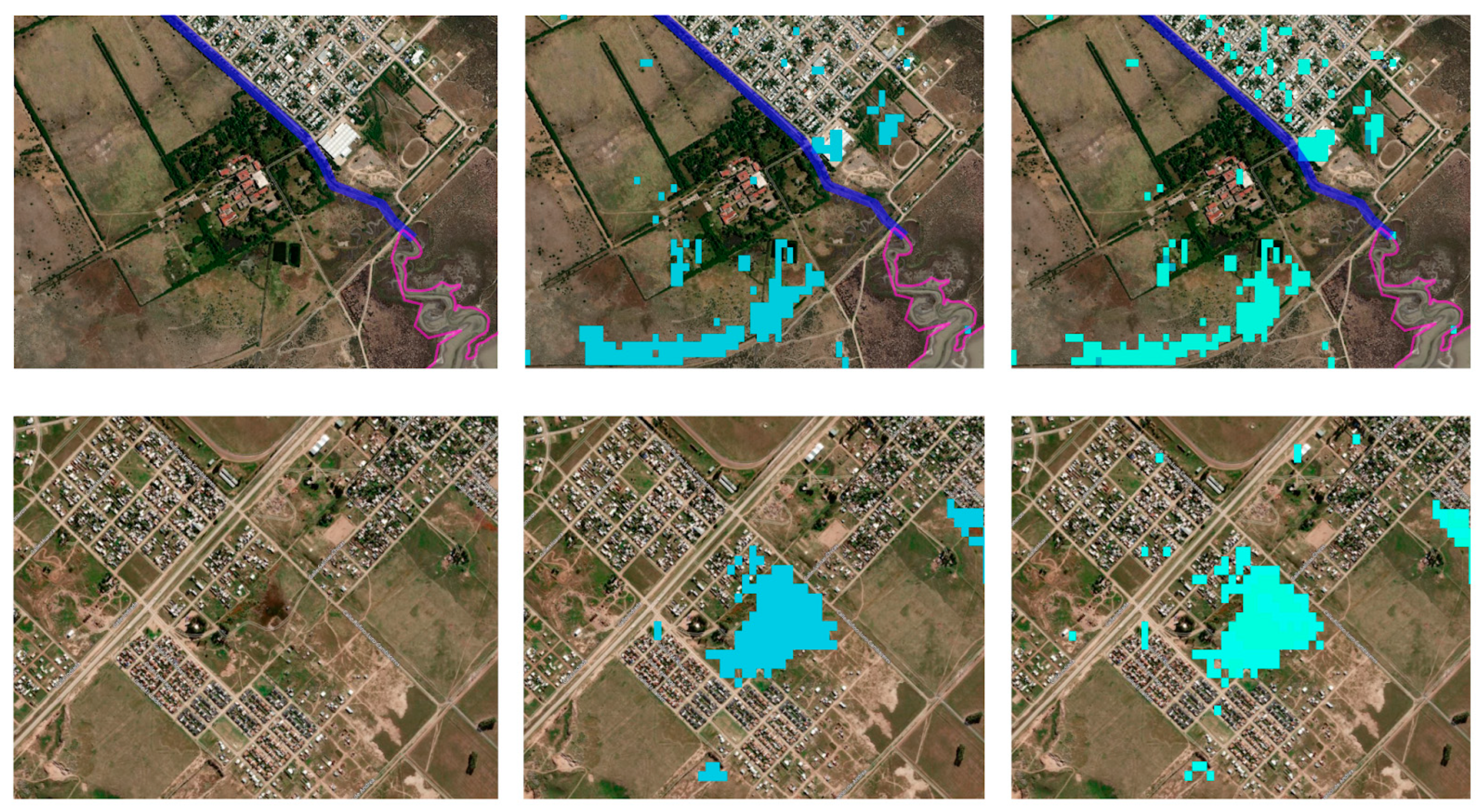
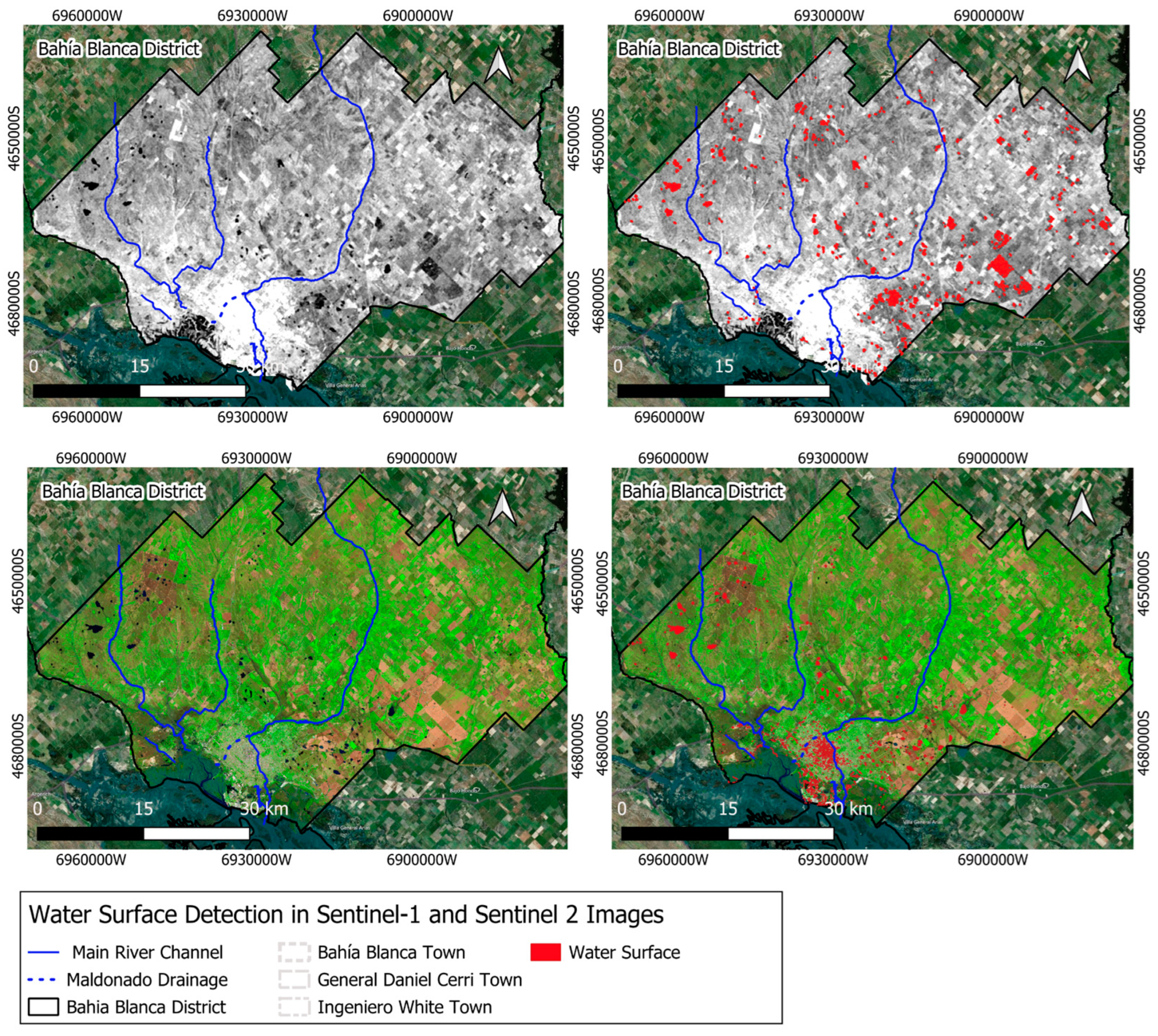
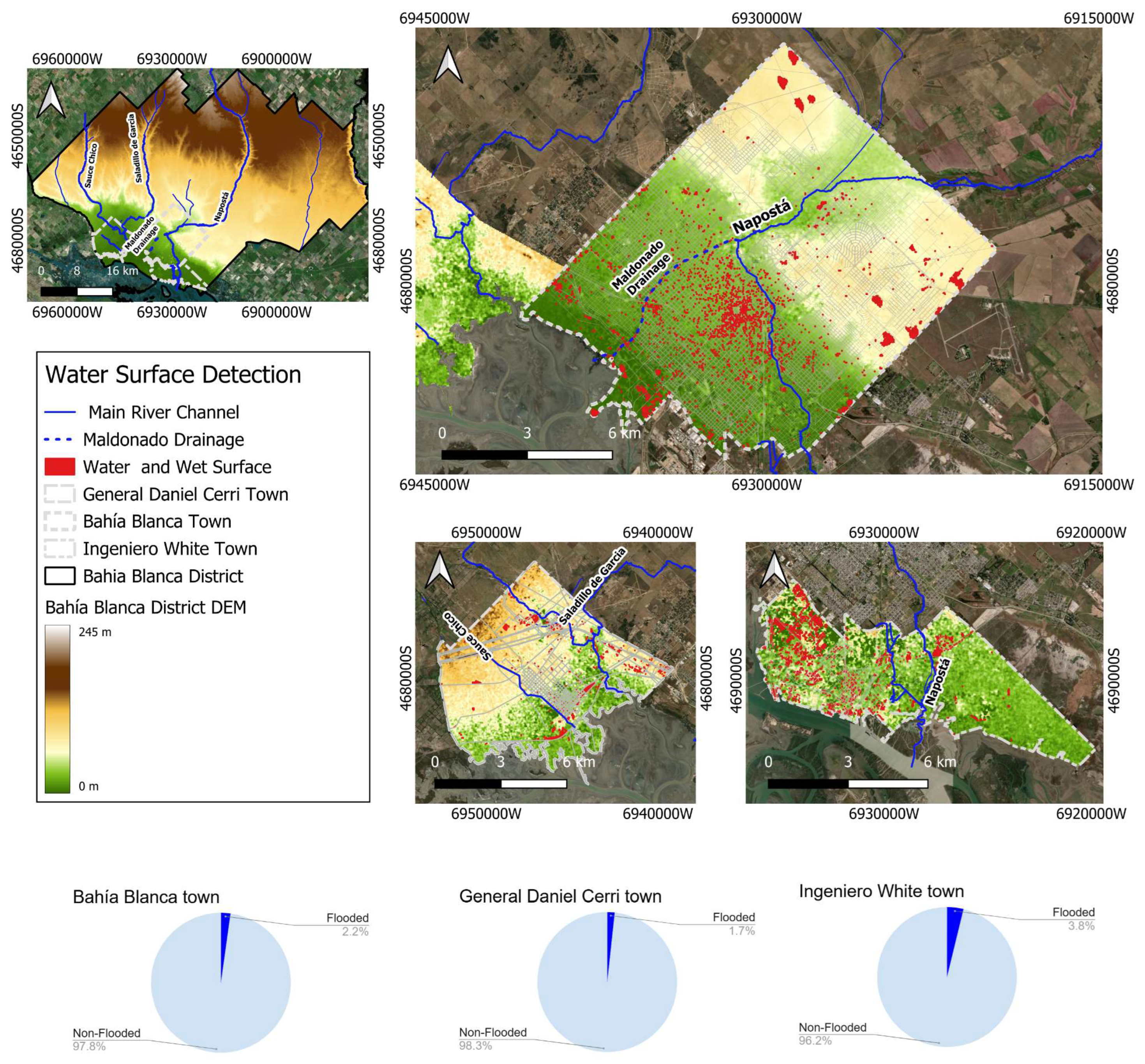
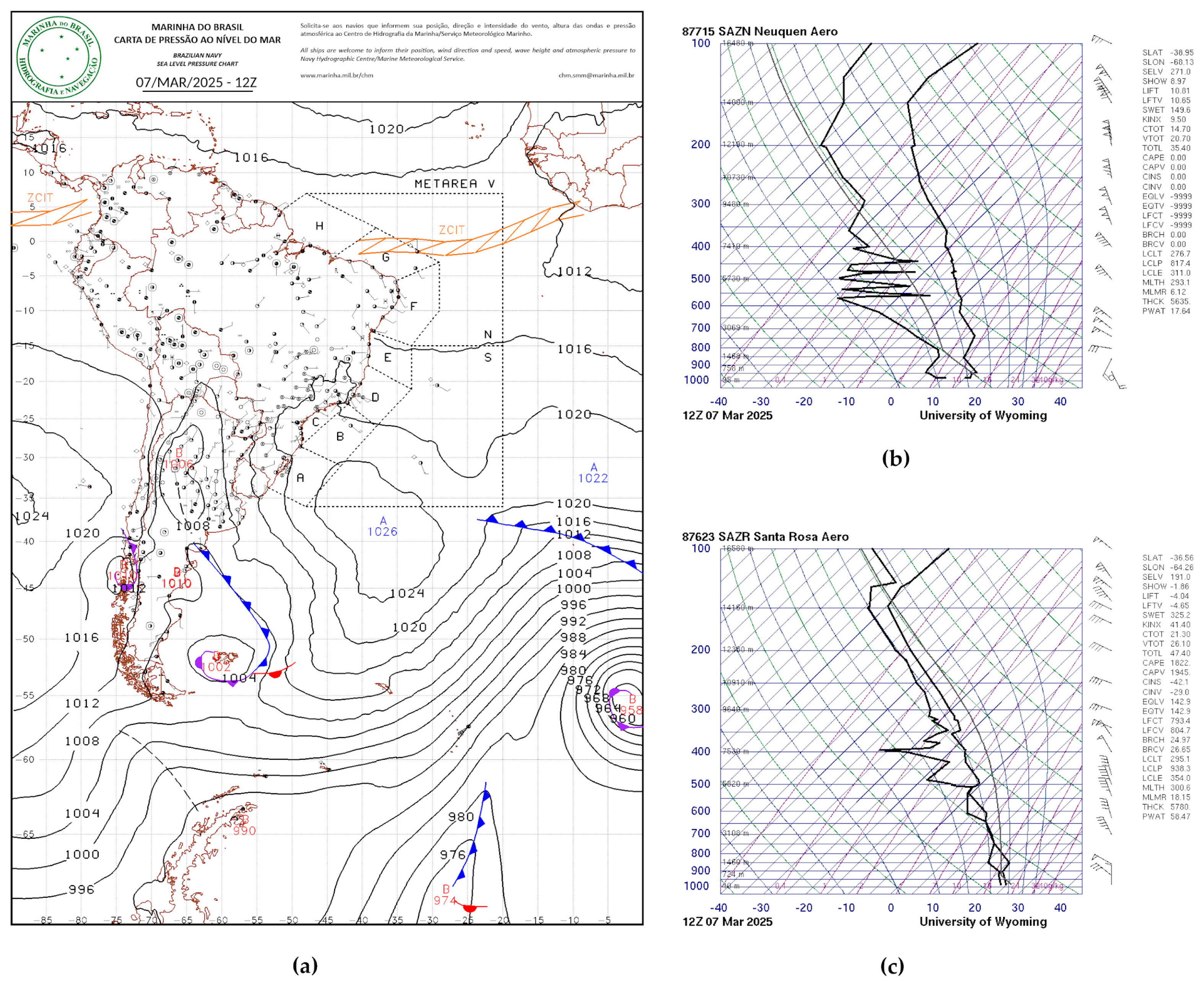
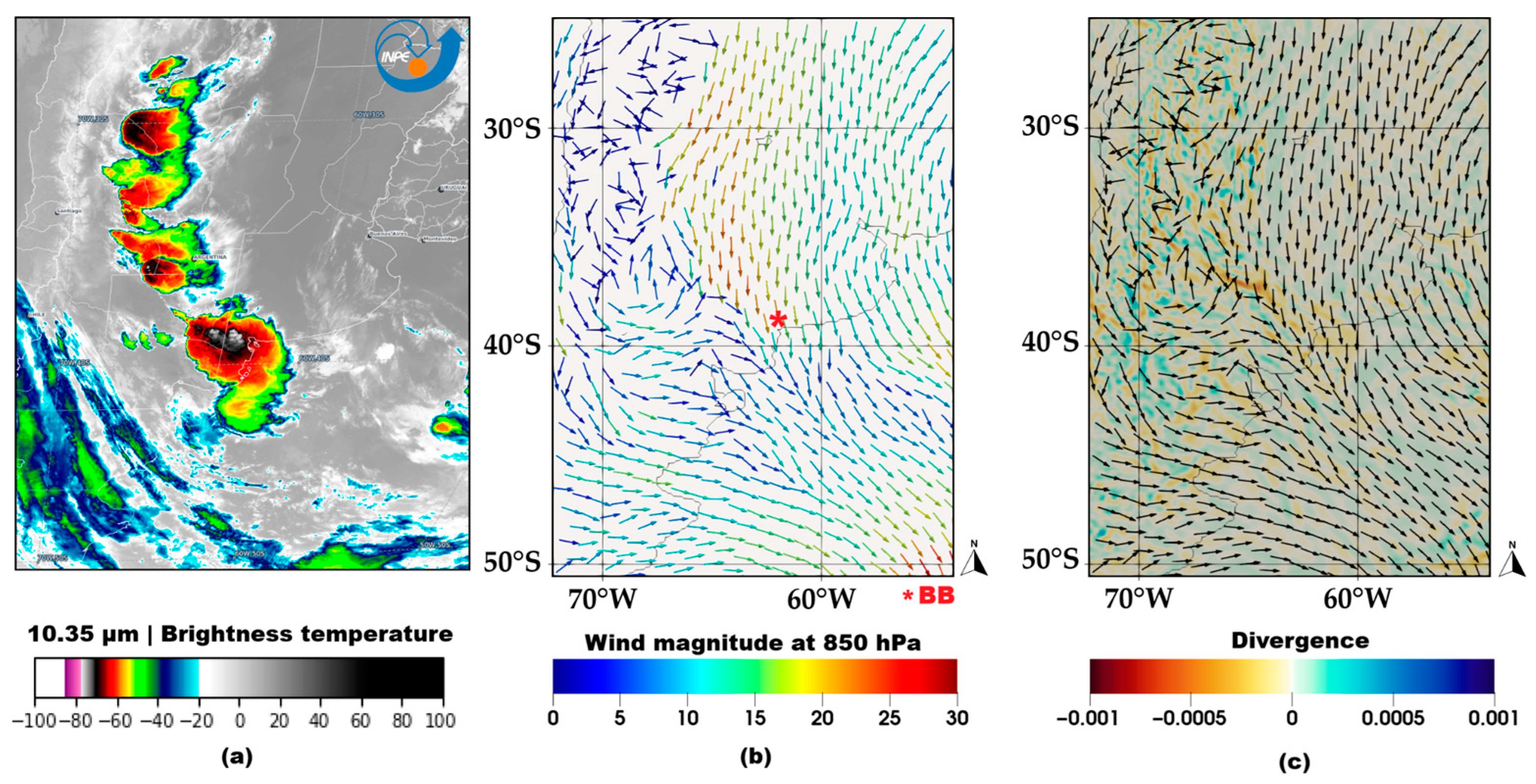
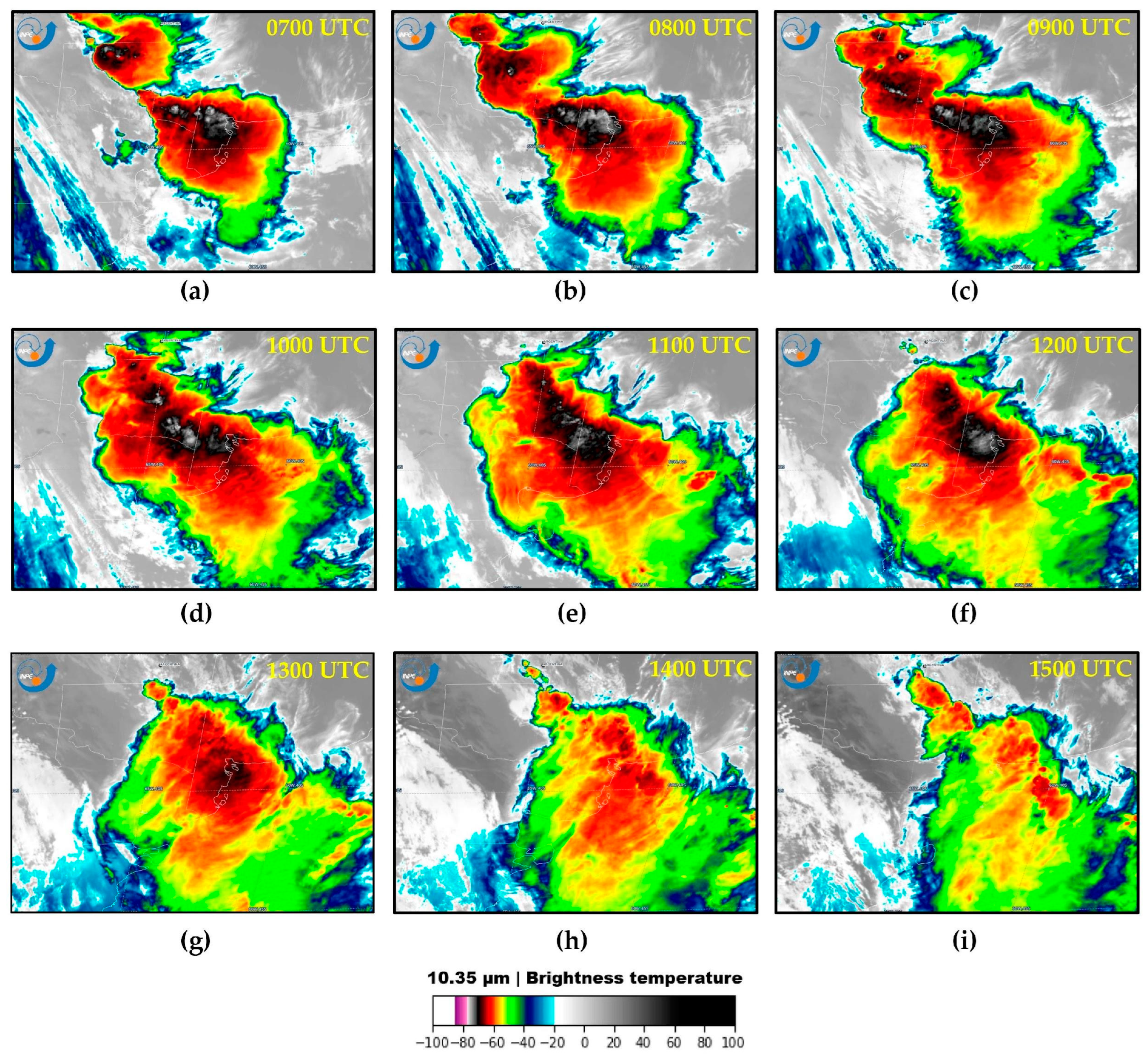

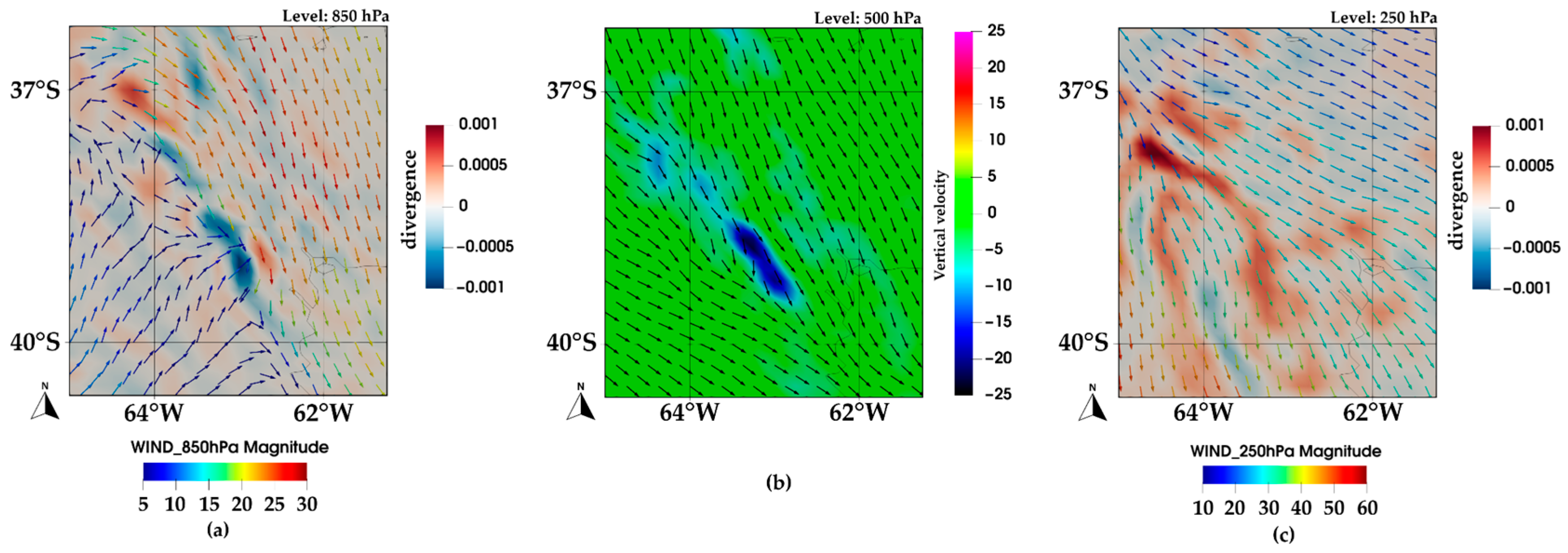
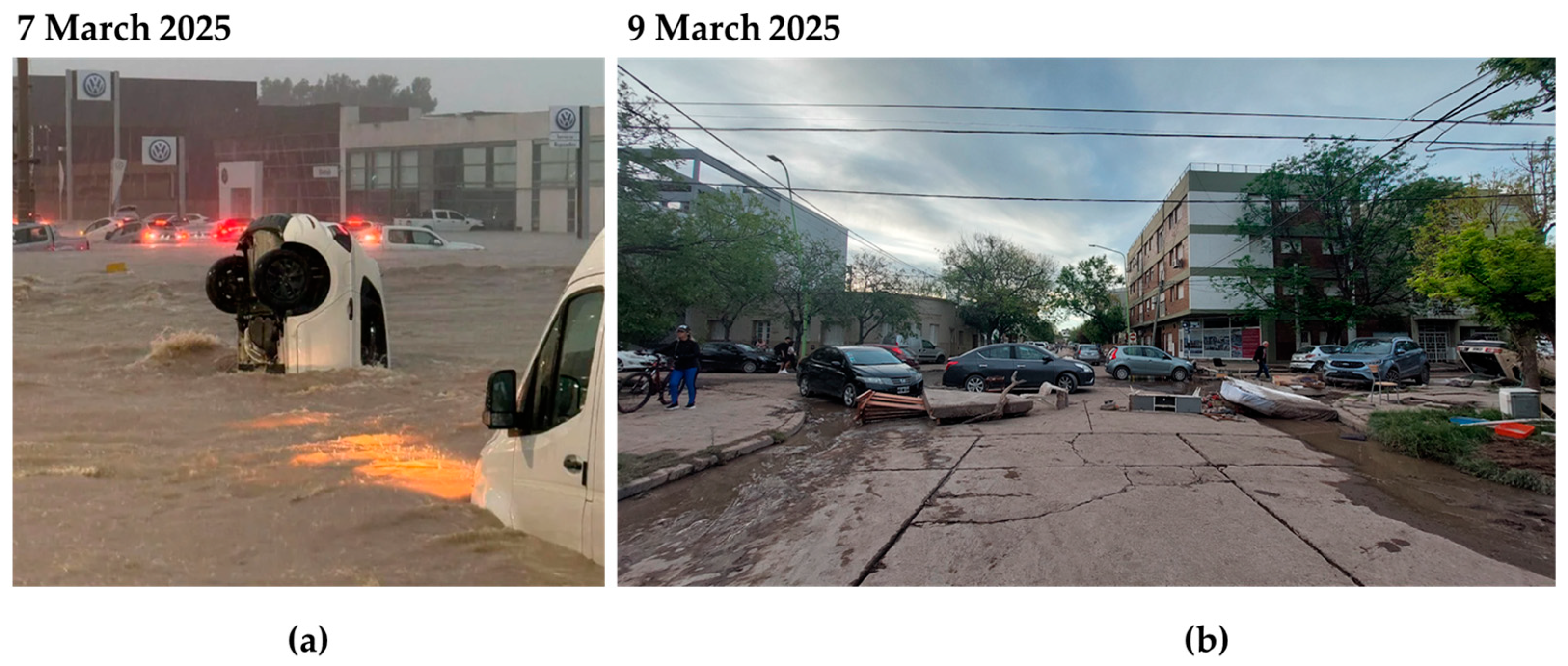
| Hour | SYNOP Code |
|---|---|
| 0600 UTC | 202503070600 AAXX 07064 87750 11765 82508 10220 20205 30002 40098 55008 60001 71392 8197/ 333 56779 57961 81950 88360= |
| 1200 UTC | 202503071200 AAXX 07124 87750 01262 81813 10198 20195 39974 40070 56001 62104 71799 81987 333 10244 20198 56777 57900 62101 88605 81940 87360 88270= |
| 1800 UTC | 202503071800 AAXX 07184 87750 11762 80511 10200 20194 39986 40083 56027 60801 76096 87027 333 56077 87556 88270= |
Disclaimer/Publisher’s Note: The statements, opinions and data contained in all publications are solely those of the individual author(s) and contributor(s) and not of MDPI and/or the editor(s). MDPI and/or the editor(s) disclaim responsibility for any injury to people or property resulting from any ideas, methods, instructions or products referred to in the content. |
© 2025 by the authors. Licensee MDPI, Basel, Switzerland. This article is an open access article distributed under the terms and conditions of the Creative Commons Attribution (CC BY) license (https://creativecommons.org/licenses/by/4.0/).
Share and Cite
Revollo, N.V.; Gil, V.; Couto, F.T. Extreme Precipitation and Low-Lying Urban Flooding in Bahía Blanca, Argentina. Atmosphere 2025, 16, 511. https://doi.org/10.3390/atmos16050511
Revollo NV, Gil V, Couto FT. Extreme Precipitation and Low-Lying Urban Flooding in Bahía Blanca, Argentina. Atmosphere. 2025; 16(5):511. https://doi.org/10.3390/atmos16050511
Chicago/Turabian StyleRevollo, Natalia Verónica, Verónica Gil, and Flavio Tiago Couto. 2025. "Extreme Precipitation and Low-Lying Urban Flooding in Bahía Blanca, Argentina" Atmosphere 16, no. 5: 511. https://doi.org/10.3390/atmos16050511
APA StyleRevollo, N. V., Gil, V., & Couto, F. T. (2025). Extreme Precipitation and Low-Lying Urban Flooding in Bahía Blanca, Argentina. Atmosphere, 16(5), 511. https://doi.org/10.3390/atmos16050511







